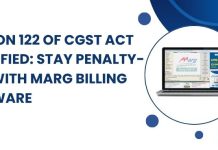Introduction
The Goods and Services Tax (GST) is a unified tax regime that has been implemented in India since July 1, 2017. However, due to the unique status of Ladakh as a Union Territory, it has its own set of rules and regulations for GST billing. In this blog, we will explore the intricacies of GST billing in Ladakh and provide a comprehensive guide for businesses operating in the region.
Understanding GST in Ladakh
Ladakh, located in the northernmost region of India, is a Union Territory that was carved out of the state of Jammu and Kashmir in 2019. The region is known for its picturesque landscapes, distinct culture, and unique economic environment. When it comes to GST billing in Ladakh, businesses need to understand the following key points:
- Dual GST: Like other parts of India, Ladakh also follows the dual GST system, which comprises of Central GST (CGST) and State GST (SGST). However, unlike other states and Union Territories, Ladakh does not have its own legislature to enact SGST laws. As a result, only CGST is levied in Ladakh, and there is no SGST component.
- UTGST: Instead of SGST, Ladakh follows the Union Territory Goods and Services Tax (UTGST) Act, which is a modified version of the SGST Act. UTGST is applicable to Ladakh and other Union Territories that do not have their own SGST Act. This means that businesses in Ladakh need to comply with UTGST regulations while generating invoices and billing their customers.
GST Billing in Ladakh
Now that we have a basic understanding of the unique GST framework in Ladakh, let’s delve into the specifics of GST billing in the region. Businesses in Ladakh need to adhere to the following guidelines for proper GST billing:
- Registration: Businesses with an annual turnover of Rs. 20 lakh or more (Rs. 10 lakh or more for special category states) are required to register under GST. This threshold limit applies to businesses in Ladakh as well. Businesses can register under GST by visiting the official GST portal and completing the registration process.
- Invoice Requirements: Invoices play a crucial role in GST billing, as they are the primary documents for recording transactions and claiming input tax credit. In Ladakh, businesses need to ensure that their invoices contain the following information:
- Name, address, and GSTIN of the supplier and recipient
- Invoice number and date
- Description, quantity, and value of goods/services supplied
- GST rate and amount (for CGST and UTGST)
- HSN or SAC codes for goods/services
- Place of supply
- Signature of the supplier
- HSN/SAC Codes: HSN (Harmonized System of Nomenclature) and SAC (Services Accounting Code) codes are used to classify goods and services for GST purposes. Businesses in Ladakh need to ensure that the correct HSN or SAC codes are mentioned on their invoices. HSN codes are required for businesses with an annual turnover of Rs. 1.5 crore or more, while SAC codes are required for businesses with an annual turnover of less than Rs. 1.5 crore.
- Bill of Supply: In some cases, businesses may not be eligible to charge GST on their invoices. For example, businesses dealing with exempted goods/services or registered under the composition scheme are not required to charge GST. In such cases, businesses need to issue a Bill of Supply instead of a regular invoice, and mention the reason for not charging GST.
- Reverse Charge Mechanism: Under the reverse charge mechanism, the liability to pay GST is shifted from the supplier to the recipient of goods/services. This mechanism is applicable in certain cases, such as when a registered dealer purchases goods/services from an unregistered dealer. In Ladakh, businesses need to ensure that they comply with the reverse charge mechanism, if applicable, and mention the same on their invoices.
- Place of Supply: Place of supply is a crucial factor in determining the applicability of CGST and UTGST. In Ladakh, businesses need to correctly determine the place of supply as per the rules laid out in the GST Act. For inter-state transactions, IGST (Integrated GST) is applicable, and businesses need to mention the place of supply and IGST amount on their invoices.
- Input Tax Credit (ITC): Businesses in Ladakh can claim input tax credit on their purchases of goods/services, subject to certain conditions. To claim ITC, businesses need to ensure that their suppliers are registered under GST, and that the invoices meet all the necessary requirements. Businesses also need to reconcile their purchase invoices with the details mentioned in their GST returns, and rectify any discrepancies in a timely manner.
Compliance and Record-Keeping
Compliance and record-keeping are crucial aspects of GST billing in Ladakh. Businesses need to maintain proper records of all their invoices, bills of supply, and other relevant documents. They also need to file regular GST returns on the official GST portal within the prescribed due dates. Non-compliance can result in penalties and fines, which can impact the business’s financials.
Conclusion
In conclusion, GST billing in Ladakh follows a unique framework due to its Union Territory status. Businesses operating in Ladakh need to understand the specific requirements of CGST and UTGST, and ensure compliance with the GST Act. Proper invoice generation, accurate determination of place of supply, adherence to reverse charge mechanism (if applicable), claiming of input tax credit, and maintaining proper records are crucial for smooth GST billing in Ladakh. Businesses should stay updated with the latest GST regulations and seek professional assistance if needed to ensure compliance and avoid any legal hassles.
GST billing can seem complex, but with proper understanding and compliance, businesses in Ladakh can smoothly navigate the GST landscape and contribute to the growth of the region’s economy. Remember, staying informed and following the rules and regulations is the key to successful GST billing in Ladakh!
Read more useful content:





